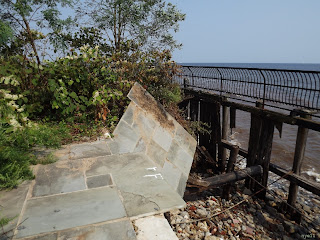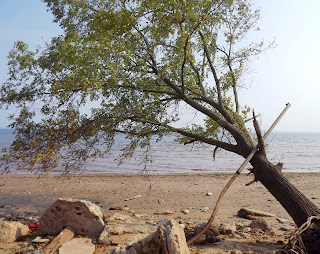The Spanish Colony was established in the 1920s on the shores of Raritan Bay by members of the Spanish Naturopath Society many of whom had fled fascism and were looking for a place to follow their principles of fresh air, vegetarian diet and exercise as a healthy alternative to modern medicine. Eventually, the camp evolved into an informal community of Spanish emigrants who were not SNS members but who paid the society rent for their campsites.
The seaside summer retreat included canvas tents on raised wooden platforms with open-air kitchens, common showers and a barn-like Salon at the center of the camp for musical performances and the annual Labor Day festival.
By the 1940s the tents were transformed into small summer bungalows; later many were winterized and became year-round residence.
In the 1920s social reformer and Catholic Worker Movement co-founder Dorothy Day began spending time on the South Shore as a retreat from increasing disillusionment with her life as a radical journalist. After the birth of her daughter, Day converted to Catholicism and was baptized in a church nearby. Her conversion motivated Day to return to Manhattan in order to pursue a mission that synthesized both the Catholic and Labor movements. She dedicated her life to promoting better treatment of the poor by setting up camps, homeless shelters and distributing food to the needy. In 1972 Day returned to Raritan Bay -- the Catholic Worker had purchased three cottages from the SNS -- where she spent the last eight years of her life in the peaceful serene setting and communal air of the Camp. Day's candidacy for sainthood is still under review by the Vatican.
In 1997, against the will of most residents, descendants of the SNS founders sold the property for $7 million to developer John DiScala, including the three cottages owned by the Catholic Worker. Residents owned their homes, but the land was the property of the Naturopath Association. The residents were evicted, but the development was blocked by legal actions from preservation groups and former residents, and by refusal of the City Planning Department to issue permits for construction. The developer had promised to preserve the home Dorothy Day lived in, and a few sample cottages. However, her home and almost all the cottages were leveled by a bulldozer as the New York City Landmarks Preservation Commission was about to declare it a historic landmark. An expediter who illegally pulled the demolition permit was later indicted for forgery.
In 2006 DiScala's firm declared bankruptcy after only a handful of the planned 80 "Central Park East" mega-houses were built -- he is trying to sell the remaining vacant land to other developers.
The remaining cottages that escaped the bulldozers
The lake and the beach strewn with construction debris
archival photos courtesy of: Jim O'Grady, The Municipal Arts Society, Staten Island Museum, jchiarella@pbase.com and the Staten Island Historian
all other photos copyright nycedges 2011-12
The seaside summer retreat included canvas tents on raised wooden platforms with open-air kitchens, common showers and a barn-like Salon at the center of the camp for musical performances and the annual Labor Day festival.
By the 1940s the tents were transformed into small summer bungalows; later many were winterized and became year-round residence.
In the 1920s social reformer and Catholic Worker Movement co-founder Dorothy Day began spending time on the South Shore as a retreat from increasing disillusionment with her life as a radical journalist. After the birth of her daughter, Day converted to Catholicism and was baptized in a church nearby. Her conversion motivated Day to return to Manhattan in order to pursue a mission that synthesized both the Catholic and Labor movements. She dedicated her life to promoting better treatment of the poor by setting up camps, homeless shelters and distributing food to the needy. In 1972 Day returned to Raritan Bay -- the Catholic Worker had purchased three cottages from the SNS -- where she spent the last eight years of her life in the peaceful serene setting and communal air of the Camp. Day's candidacy for sainthood is still under review by the Vatican.
In 1997, against the will of most residents, descendants of the SNS founders sold the property for $7 million to developer John DiScala, including the three cottages owned by the Catholic Worker. Residents owned their homes, but the land was the property of the Naturopath Association. The residents were evicted, but the development was blocked by legal actions from preservation groups and former residents, and by refusal of the City Planning Department to issue permits for construction. The developer had promised to preserve the home Dorothy Day lived in, and a few sample cottages. However, her home and almost all the cottages were leveled by a bulldozer as the New York City Landmarks Preservation Commission was about to declare it a historic landmark. An expediter who illegally pulled the demolition permit was later indicted for forgery.
In 2006 DiScala's firm declared bankruptcy after only a handful of the planned 80 "Central Park East" mega-houses were built -- he is trying to sell the remaining vacant land to other developers.
The remaining cottages that escaped the bulldozers
The lake and the beach strewn with construction debris
archival photos courtesy of: Jim O'Grady, The Municipal Arts Society, Staten Island Museum, jchiarella@pbase.com and the Staten Island Historian
all other photos copyright nycedges 2011-12























Fascinating, as ever. Worlds inside worlds inside worlds ...
ReplyDeleteThe story of the Spanish camp is very interesting. The place should be a very nice one when some people paid rent to live there.
ReplyDeleteI used to have a friend that lived in the Spanish Camp. I remember being fascinated by her home and loving the time we spent wandering the neighborhood. It's a shame to see it gone.
ReplyDeleteMy father's uncle owned a cottage near the 'Community Center'. We visited there in the 1940's and 1950's.There was a group of Scandinavians who leased the land but the majority was Spanish. There was music and dances in the Community Center of a Spanish theme. It was a very unique place, especially for a kid. There was the beach and the woods to explore. It was a private and rustic retreat.
ReplyDeleteIt is a shame how it ended up as developers pillaged the settlement because it was waterfront property which became very expensive and gentrified.
It was the brainchild of a few visionary spaniards who wanted a summer retreat for themselves and their families. It was an idealic place to spend summers...fishing, swimming, camping, baseball field, picnic grounds...and all in your own private community.
ReplyDeleteI grew up in Spanish camp back in the 80's and 90's. I will never lose the memories I have of that paradise. I miss everything about it. I often have flashbacks of my bungalow when i smell the ocean air. It's sad to think I will never be able to raise my daughter there, she will never see and experience the fun I had living there, she will only hear the great stories. Videos and friends/family is what remains. I'm still thankful.
ReplyDeleteFirst Time in NY, visiting from far south, I enjoyed and played in the Camp for few months, summer of '71. My uncle, aunt & cousin were living there, no far from senora Agueda's place...I remember eating mussels almost every day!
ReplyDeleteThe pond, the beach, the kermes, Hylan Blvd., the beachcomber,WABC on the radio.
Wandering around the woods I got Poison Ivy!!
What a superb place for children.
What a superb place for children
After the recognition of Dorothy Day by the Pope, I have searched for pictures of her and found her on this website of Spanish Camp where she spent her later years. This website is a wonderful historic snapshot of what Spanish Camp was, but I am happy to announce here that I have boxes full of home movies made by mother, earlier mentioned by someone on this blog as Sra. Agueda which I have not had the chance to digitally convert to video but that I know would amaze the world to see how idyllic Spanish Camp living was like, and I would not be surprised in the least, if Dorothy was a part of the many Spanish Camp activities. I was so happy to see the pictures of her on this website! It confirmed for me that yes, this was the same Dorothy Day
ReplyDeleteI remembered as a child. Yes! That’s her, that’s her! I thought. The same lady with the silver hair who usually sat at the side of her cottage which faced the beach, and sometimes waved and always but always smiled and said a very friendly“Hello” as we children passed. The Pope’s recognition of her worth has affected me very deeply as I realize the great opportunity that we children missed to get to know her better, she was our neighbor, she was gracious enough to always give us a warm smile, almost beckoning us to stop by and get to know her, yet we had no idea who she was. I would pass her by and thought it enough to smile back and return her warmth with a short “hi” and I was doing my share to be nice when in fact, it would have done myself a world of good to get to know her, especially in my teenage years, when I was especially self-absorbed and would have benefited from hearing her stories, especially about her views on the Spanish Civil War. This war directly affected me since my mother had survived it, and had very passionate views and experiences of it. I am in fact, now so many years later, in the process of writing my mother’s biography, which will not only include the horrific war, but also her immigrant story transitioning to the idyllic Spanish Camp. I hope I have time and money to transfer these home movies to video to see if I can find Dorothy Day in one of the many community activities my mother recorded. I have a strong feeling both of them will appear together somewhere. Lessons to be learned: It’s a small world. We are all connected in some way. We just need to make every effort to connect with each other and take nothing for granted.
I remember this place well, although I knew it as Spanish Colony back then. I went there many times as a teen in the early 1970's with my girlfriend at the time, she called it the "country".
ReplyDeleteHer family was part of the many families that owned bungalows and spent their summers and weekends there.
Some lived there all year round, such as her grandparents. I still remember her grandmother's delicious food and her Puerto Rican mojito dressing. Sweet lady. I've often thought of this idyllic little getaway from Manhattan with fondness. Grateful for that beautiful young girl showing me, a misguided city youth from the upper west side that experience. Good memories.